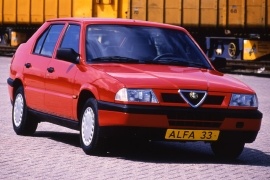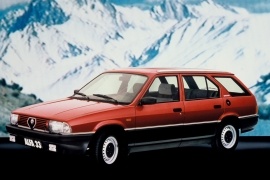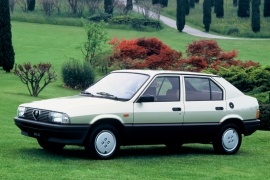ALFA ROMEO 33 Models/Series Timeline, Specifications & Photos
First production year: 1983
Engines: Gasoline
Alfa Romeo introduced the last facelift for the aging 33 model in 1990 and named it Series II, or "Nuova," improving the vehicle both inside and outside.
Even for the Italians, it was hard to hide the age of the 33 lineup. Yet, they tried hard and created a vehicle that could not only outperform its predecessor but also look up to date, even though it was based on a car launched in 1983. But Alfa Romeo was not exactly in the financial situation to completely replace the vehicle and had to keep the 33 on the market for another five years until 1995, when it introduced the 145/146 lineup.
With a new front fascia that showed tilted and redesigned headlights and a body-colored rim around the grille, the 1990 33 looked like it was fresh on the market. On its profile, the carmaker added redesigned door mirrors that matched the car's color. Yet, the flush door handles were left black, unpainted. Depending on the version, a small wing was added to the trunk at the back.
Another major improvement was on the inside, where Alfa Romeo improved not only the materials' quality but also redesigned the entire dashboard. Also, the center stack featured dials instead of sliders for the HVAC system. Depending on the options, the car also sported leather upholstery, power windows and locks, and a cassette player.
Under the hood, the most significant upgrade was for the 1.7-liter boxer engine that offered up to 132 hp (133 PS). It was also available with an all-wheel drive system.
Alfa Romeo tried to do something different than most competitors on the market and introduced a crossover version for the 33 range, long before the term entered into the automotive dictionary.
The Italian brand was new on the all-wheel-drive systems, but it still tried to offer a vehicle that could cope well with snowy roads and other slippery surfaces. Since most 4x4 vehicles sported a higher ground clearance, the carmaker added a lift kit to make the car more capable on unpaved roads.
The Italian carmaker worked with Pininfarina to develop the Giardinetta (Station Wagon) version of the Alfa 33. It was 13 cm (5.1”) longer than its hatchback brother and featured an extended roof over the trunk area. It was still wedged-shaped, but that was right for those times. The carmaker added the third set of windows covering side areas between the rear doors and the raked-forward D-pillars. A set of black plastic moldings protected the lower side of the bodywork from stone chips, bushes, and the usual shopping carts.
Inside, the car was similar to the regular Alfa 33. It sported a three-spoke steering wheel and a narrow, flat-designed dashboard. There was room for two adults at the front, separated by a small transmission tunnel between them. On the other hand, that tunnel prevented the car from accommodating three passengers in the back comfortably.
Under the hood, Alfa Romeo installed a 1.5-liter engine paired to an all-wheel-drive system with a Torsen center differential. But the engine was too small and the car too heavy for it. That led to big fuel consumption. Later on, Alfa Romeo dropped the Giardinetta with its all-wheel-drive system.
The 1983 Alfa Romeo 33 was produced in over one million units between 1983 and 1994. It replaced the Alfasud and it was renowned for its nimble handling.
Alfa Romeo had to move forward and increase its sales. To do that, they had to change the rear-wheel-drive platforms to front-wheel-drive so the cars would handle better and be easier to drive. Despite the Alfa Romeo fans, the evolution had to be done. After the Alfasud, Alfa 33 was a very important car for the Italian brand. It was nimble, affordable, and easy to drive. It was offered as a hatchback, station-wagon, and even in 4x4 configuration with higher ground clearance. Something that, years later, would have been named a crossover. It was ahead of its time.
At the beginning of the '80s, the customers were looking for cars with sharper edges. It was the idea that a boxier looking car would be safer to drive. That trend was followed by most of the car manufacturers in Europe. So it was the Alfa 33, with its sharp, straight lines, square headlights and trapezoidal taillights. The two-and-a-half body style was appealing for Italian customers.
Inside, the Alfa 33 featured an innovative dashboard, with a center console designed as a separate unit from the instrument cluster. The binocular-style dials were something new on a market that offered only a panel with gauges on it. Due to its platform, the interior room was good enough for five adult passengers. The rear seats backseat could have been folded and increase the, otherwise small, trunk.
The Alfa 33 featured boxer engines, helping to lower the center of gravity and improve handling. With the introduction of the 4x4 on demand and, later on, permanent all-wheel-drive system, the car handled well even on unpaved roads.


